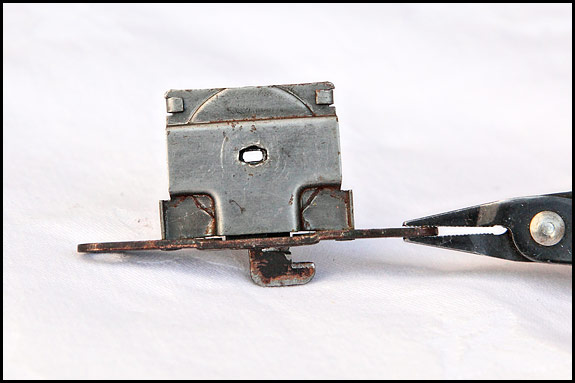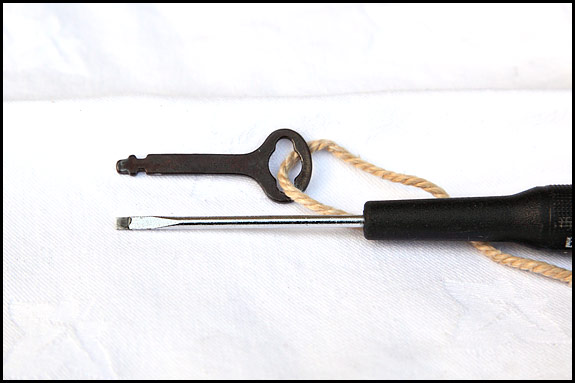Some people call them domed lids, and on the internets you’ll sometimes see them called doomed lids, but what we’re on about here are properly called bentwood case lids. Specifically, Singer bentwood lids and how to open one without the key. And if you’re thinking that surely any fule kno how, I can assure you that they don’t.
So, somebody’s inherited that old sewing machine of Grannie’s, and quite naturally they want to have a look at it now they’ve got it home. But oh dear there is no key, so how will they get in it? Enter the Man About The House, who takes stock of the situation, and in entirely typical fashion says “Leave it to me” as he reaches for his toolbox. Naturally he can’t find in it the small chisel he had in mind for the job, but a Stanley knife and a screwdriver will do the business no problem …
Having hacked away enough 70-year old polished oak to reveal what’s what, it’s immediately apparent to our hero how it all works and what’s called for, which is a small hacksaw blade with which to saw through the tongue of the lock, et voilà! With a bit of jiggling, the lid lifts off …
Of course the lock is now useless and the base of the machine is damaged in such a way that it would take a skilled cabinetmaker to restore it, but hey, you can’t win ’em all. The idea was to get the lid off, and the lid is now off. Sorted!
What a shame our hero didn’t try the obvious …
OK, what you need to know is that the locks on most Singer bentwood case lids are much of a muchness. The keyhole in the lids we’re on about is round as shown above as opposed to keyhole-shaped, and if you take the lock out by undoing those two screws seen in the second picture, it looks something like this …
That oblong hole that you can see through in the middle of the lock is the hole into which the end of the key fits, and it’s actually in a part which is sandwiched inside the lock casing. On some of these locks the hole in that outer casing will be a bit smaller than this one, on some a bit bigger and on others it’ll be chewed up, but it makes no difference as far as we’re concerned here. Also, the (rusty) sticky-outy bit at the bottom shown above is only one of the two that should be there, because matey sawed the other one off this particular lock.
There should be one of those danglers facing each way. When the lock’s locked, they hook under the ends of the slot in the metal plate in the end of the base, and that’s what locks your case lid. When you unlock it, the two sticky-outy bits move back towards each other, so the hooks clear the end of the slot and you can lift the lid up. It’s about as simple as it could get, but it works extremely well.
Now, there’s no prizes for spotting the similarity here between the proper Singer key and the small screwdriver which most owners of Singers in bentwood cases use instead. Yes indeed, all you need to open one is a flat-bladed screwdriver like that with a tip that’s about 3mm wide, and having armed yourself with one of those, the correct procedure is as follows:-
Look into the keyhole (using a torch if necessary) to get an idea of the size of the slot and see which way it’s aligned.
Poke your screwdriver into it. If there’s no way you can feel it locating in that slot, try a screwdriver that’s a bit narrower.
Once you’re fairly sure your screwdriver’s in the slot, turn it clockwise. It will probably be harder to turn than you were expecting it to be.
If you’re sure your screwdriver’s engaged properly but the lock won’t turn clockwise, try turning it the other way.
If still no luck, show somebody else this blog post and let them have a go.
If all else fails, apply a few drops of thin oil (or better still penetrating oil) and try turning one way then the other several times as the oil soaks in.
If you’re still stuck, come back and add a comment under this post and we’ll see what we can do to help!






Thank you! It gave me all the clues I needed to open my old Singer case again.
Okay, and thank SO much for this information. I’m adding a 3mm screw driver to my keychain.
Thank you so much! I now have my beautiful 1939 Vintage Singer Sewing Machine open with no damage to the case.
I got my beautiful vintage machine unlocked and thanks to you tube found a video on how to wind the bobbin….she is threaded and full bobbin and raring to go.I am so excited!
i lost the key to my antique singer in a move.Thank you soooo much!
Seriously fantastic! Thanks so much it took me less than a minute to get the lid off of my Singer model 15•91.
Douglas, seeing as how your locksmith took yours apart, I would be surprised if he doesn’t know how those locks are put together. But whatever, if I was you I’d just bide my time and find a cheap bentwood case with a working lock of the same type (which it will be if it’s for the same model and the fittings on the other end of the case are the same).
I had problems unlocking one of my Singers – it’s my favorite – so I took it to the local locksmith. The key would turn the right way, but maybe only 85 of the 90degrees required to unlock the case. The locksmith was able to get it open and when he unscrewed the lock from the case, we discovered that a flat metal spring was broken.
What are my options now?
– can the spring be replaced?
– keep my eyes open for a damaged bentwood case, and take the lock from it?
For now, I’m just setting the case over the machine to keep dust out, but it would be nice to replace or repair the lock.
I’ve also thought about unscrewing one of the locks from one of my other Singers bentwood cases, and taking it in the locksmith so he can see how it’s put together… Maybe that will give him some ideas, too.
This was fantastic – thank you so much. intruction are like reading a good manual – José
These things frequently appear on Ebay, although there are actually two types (different size blade end). It’s not guaranteed, but if you have a choice of two blade widths, go for the one which is narrower at the business end 😉
The screwdriver hint worked on the bentwood case for my 1913 Singer handcrank machine. Is there anywhere I can locate a key for the case? Right now I have the screwdriver tied to the case so I can take it with me and be able to lock/unlock it. But a key would be easier to travel with. Thanks for any advice.
I have a 1910 Treadle machine that I am restoring at the moment and would like to add that the locks on the hanging drawers are anticlockwise to lock and clockwise to unlock. The other locks on the machine, table top and drawer, are clockwise to lock and anticlockwise to unlock. And the screwdriver workaround is certainly easier than trying to purchase the correct key over the web!
thanks so much… just to find the key… it’s here somewhere and for the life of both of us (hubby and wife on 50y.o.), we’re not doing so well remembering what we did when the old string broke and we couldn’t thread the key through the handle anymore, but all we do remember is me going to put an elastic band through the key and then all goes blank… oi, old age… but yeah, thank you a million times over for doing this… I wondered if I was worthy of finding a kind person who had posted the answer to my question, and my mind kept darting to the horror that I wouldn’t find anything on the http://www... LOL!!! but Lo and Behold – the genius keeps marching on!!!!!! Thanks…
Hi Sid,
Thank you very much for your instructions! It took me not more than 10 min to unlock my wooden case.
If you can lift the end you unlocked up slightly, the lid should push about 5mm towards that end. If it won’t, I can’t imagine why not 😦
I have unlocked my case, but the back end won’t release. What do I do? It won’t slide forward or back, but slightly twists. I’m afraid to break anything. Help!!! Please
Tommy, AFAIK it’s designed like that so you can’t lose the key 🙂
Hi Sid,
SInce I wrote last, I have managed to find the original key to the Singer I mentioned in my earlier comments. I have a question regarding it, however.
I put the key in, and turn it, to unlock the case. However, the key won’t then release itself from the lock, when it’s in the “unlocked” position. When I turn the key back to the “locked” position, it slides out comfortably.
Why is this? Is it a specific part of the lock-design, to prevent missing keys? I was curious about this.
Glad that worked. Have fun with it 🙂
Hi Sid,
I got some general-purpose lubricating oil and squirted a decent dose of it down the keyhole. A few minutes of waiting, another jiggle with the screwdriver and a bit of extra pressure and it’s open!
This screwdriver trick of yours really is a wonder. when I saw the keyhole, I had no idea how the hell I’d open it, but you found the way. Thanks very much for this tip! Works an absolute treat! The screwdriver ‘key’ turns clockwise to unlock, anticlockwise to lock.
Everything’s there. Including the curved knee-bar! I thought gran had lost that years ago.
WD-40 if you don’t have any light oil, and try turning it counter-clockwise too 🙂
HELP!!
I have recently dug my grandmother’s vintage SINGER sewing machine out of the depths of the household catacombs. I’m about 75% sure it’s a 1930s Model 99. But I have a problem.
It’s locked inside its bentwood case.
I’m fortunate in that I DO have a 3mm flathead screwdriver, but while it fits into the keyhole, it won’t TURN!
What lubricant should I use to unlock the case? I’m currently turning CLOCKWISE.
I have WD-40 and I also have graphite-powder. Which one would work best?
Your directions worked like a champ and saved our case! I cannot thank you enough for the article and photos! I originally thought the large hole in the front of the case must give access to a crank mechanism to withdraw cams or something, so I even was looking at the wrong hole in the case. Your post is much appreciated.
Thank you so much for this information. I cannot believe I found such detailed information online! It worked exactly as you stated and saved me the time and money required to take the machine to a locksmith!
🙂 Glad to be of assistance …
You Have no Idea how much this helped! thanks a million.